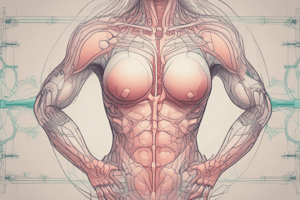Podcast
Questions and Answers
What is the location of the breast tissue in relation to the rib cage?
What is the location of the breast tissue in relation to the rib cage?
- From the 5th to the 9th rib
- From the 4th to the 8th rib
- From the 1st to the 5th rib
- From the 2nd or 3rd rib to the 6th or 7th rib (correct)
What is the axillary tail?
What is the axillary tail?
- A type of breast cancer
- A prolongation of the parenchyma that passes deeply through an opening in the deep fascia (correct)
- A vein that drains the breast tissue
- A ligament that connects the breast to the rib cage
What is the primary source of arterial supply to the breast?
What is the primary source of arterial supply to the breast?
- Internal mammary artery (correct)
- Thoracoacromial artery
- Axillary artery
- Posterior intercostal arteries
What is the primary mode of venous return from the breast?
What is the primary mode of venous return from the breast?
What is the significance of the perforating branches of the internal mammary artery during mastectomy?
What is the significance of the perforating branches of the internal mammary artery during mastectomy?
What is the extent of the breast tissue in the transverse plane?
What is the extent of the breast tissue in the transverse plane?
What is the significance of the deep fascia in relation to the breast tissue?
What is the significance of the deep fascia in relation to the breast tissue?
What is the relationship between the breast tissue and the surrounding muscles?
What is the relationship between the breast tissue and the surrounding muscles?
What is the term for aberrations of normal development and involution?
What is the term for aberrations of normal development and involution?
What is the most frequent disorder of the breast?
What is the most frequent disorder of the breast?
What is the term for the formation of multiple accessory breasts?
What is the term for the formation of multiple accessory breasts?
What is the term for the inflammation of the mammary ducts?
What is the term for the inflammation of the mammary ducts?
What is the term for the absence of breast tissue?
What is the term for the absence of breast tissue?
What is the term for the inflammation of the breast tissue during lactation?
What is the term for the inflammation of the breast tissue during lactation?
What is the term for the abnormal growth of breast tissue in males?
What is the term for the abnormal growth of breast tissue in males?
What is the stage of life where the breast tissue undergoes involution?
What is the stage of life where the breast tissue undergoes involution?
What is the primary goal of treatment for ANDI?
What is the primary goal of treatment for ANDI?
What is the purpose of performing a biopsy on a recurring cyst in ANDI?
What is the purpose of performing a biopsy on a recurring cyst in ANDI?
What is the recommended treatment for mild cases of cyclic mastalgia in ANDI?
What is the recommended treatment for mild cases of cyclic mastalgia in ANDI?
What is the dose of Danazol used to control cyclic pain in ANDI?
What is the dose of Danazol used to control cyclic pain in ANDI?
What is the significance of the intercostal veins in relation to breast cancer?
What is the significance of the intercostal veins in relation to breast cancer?
What is the recommended follow-up for cases with atypical epithelial hyperplasia discovered by biopsy in ANDI?
What is the recommended follow-up for cases with atypical epithelial hyperplasia discovered by biopsy in ANDI?
What is the purpose of giving up caffeine consumption in the treatment of ANDI?
What is the purpose of giving up caffeine consumption in the treatment of ANDI?
How do lymph vessels typically follow the course of blood vessels in the body?
How do lymph vessels typically follow the course of blood vessels in the body?
What is the purpose of dividing the axillary lymph nodes into three levels?
What is the purpose of dividing the axillary lymph nodes into three levels?
Which of the following hormonal stimuli is NOT involved in breast development and function?
Which of the following hormonal stimuli is NOT involved in breast development and function?
At which level are the axillary lymph nodes located medial or above the pectoralis minor muscle?
At which level are the axillary lymph nodes located medial or above the pectoralis minor muscle?
What is the primary physiological change that occurs in the breast during pregnancy?
What is the primary physiological change that occurs in the breast during pregnancy?
What is the primary location where carcinoma of the breast arises from?
What is the primary location where carcinoma of the breast arises from?
What is the term for the occurrence of a second breast cancer outside the breast quadrant of the primary cancer?
What is the term for the occurrence of a second breast cancer outside the breast quadrant of the primary cancer?
What is the term for the carcinoma that remains within the epithelium?
What is the term for the carcinoma that remains within the epithelium?
What percentage of cases have bilateral lesions in lobular carcinoma?
What percentage of cases have bilateral lesions in lobular carcinoma?
What is the term for the occurrence of a second cancer within the same breast quadrant as the primary cancer?
What is the term for the occurrence of a second cancer within the same breast quadrant as the primary cancer?
What is the type of carcinoma that begins in the epithelium and is essentially an intraductal carcinoma?
What is the type of carcinoma that begins in the epithelium and is essentially an intraductal carcinoma?
What is the name of the type of carcinoma that arises from the ducts?
What is the name of the type of carcinoma that arises from the ducts?
What is the percentage of infiltrating ductal carcinoma among all breast carcinomas?
What is the percentage of infiltrating ductal carcinoma among all breast carcinomas?
Flashcards are hidden until you start studying
Study Notes
Functional Anatomy of the Breast
- The mature female breast overlies the area from the 2nd or 3rd rib to the inframammary fold at the 6th or 7th rib.
- It extends transversely from the lateral border of the sternum to the anterior axillary line.
- The deep or posterior surface of the breast rests on the fascia of the pectoralis major, serratus anterior, and external oblique abdominal muscles, and the upper extent of the rectus sheath.
- The axillary tail (of Spence) is a prolongation of the parenchyma which passes deeply through an opening in the deep fascia to blend with the axillary fat.
Blood Supply
- Arterial supply comes from the following arteries in order of their contribution:
- Perforating branches of the Internal mammary artery
- Lateral branches of the posterior intercostal arteries
- Branches from the axillary artery, including the highest thoracic, lateral thoracic, and pectoral branches of the thoracoacromial artery
Veins
- The venous return is primarily through the axillary and internal mammary veins.
- The intercostal veins are clinically important as they drain into the azygos system and communicate with the valveless vertebral venous plexus (Batson's).
Lymphatic Drainage
- Lymph vessels follow the course of blood vessels.
- The six axillary lymph node groups are:
- Axillary nodes (lateral)
- Anteromedial (pectoral) or external mammary
- Posterior (subscapular) group
- Central group
- Apical group (subclavicular)
- Interpectoral (Rotter)
- The axillary lymph nodes are divided by the pectoralis minor muscle into three levels:
- Level I nodes: located low in the axilla, lateral or below the lower border of the pectoralis muscle
- Level II nodes: located superficial or deep to the pectoralis minor muscle
- Level III nodes: located medial or above the muscle in the apex of the axilla
Physiology of the Breast
- Hormonal control: estrogen, progesterone, and prolactin modulate breast development and function.
- Physiological changes occur at puberty, during menstruation, pregnancy, lactation, and after menopause.
Congenital Anomalies
- Anomalies of the nipple
- Anomalies of the breast
- Accessory breasts (polymastia)
- Accessory nipples (polythelia)
- Inverted nipple
- Enlarged breasts
- Amastia
- Accessory axillary breast
Diseases of the Male Breast
- Gynecomastia
- Male breast cancer
Studying That Suits You
Use AI to generate personalized quizzes and flashcards to suit your learning preferences.


